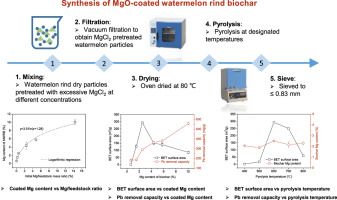当前位置:
X-MOL 学术
›
Environ. Res.
›
论文详情
Our official English website, www.x-mol.net, welcomes your feedback! (Note: you will need to create a separate account there.)
Effects of excessive impregnation, magnesium content, and pyrolysis temperature on MgO-coated watermelon rind biochar and its lead removal capacity.
Environmental Research ( IF 8.3 ) Pub Date : 2020-01-20 , DOI: 10.1016/j.envres.2020.109152 Jingzhuo Zhang 1 , Deyi Hou 1 , Zhengtao Shen 2 , Fei Jin 3 , David O'Connor 1 , Shizhen Pan 4 , Yong Sik Ok 5 , Daniel C W Tsang 6 , Nanthi S Bolan 7 , Daniel S Alessi 8
Environmental Research ( IF 8.3 ) Pub Date : 2020-01-20 , DOI: 10.1016/j.envres.2020.109152 Jingzhuo Zhang 1 , Deyi Hou 1 , Zhengtao Shen 2 , Fei Jin 3 , David O'Connor 1 , Shizhen Pan 4 , Yong Sik Ok 5 , Daniel C W Tsang 6 , Nanthi S Bolan 7 , Daniel S Alessi 8
Affiliation

|
MgO-coated watermelon rind biochar (MWRB) is a potentially highly-effective waste-derived material in environmental applications. This research aims to provide valuable insights into the optimization of the production of MWRB for superior environmental performance. It was found that the Mg content of the MWRB could be easily controlled by adjusting the Mg/feedstock mass ratio during excessive impregnation. The BET surface area was found to first increase and then decrease as the Mg content of the MWRB (produced at 600 °C) increased from 1.52% to 10.1%, with an optimal surface area of 293 m2/g observed at 2.51%. Similarly, an optimum pyrolysis temperature of 600 °C was observed in the range of 400-800 °C for a maximum surface area of the MWRB at a fixed Mg/feedstock ratio of 0.48% (resulting in MWRBs with Mg contents of 1.89-2.51%). The Pb removal capacity of the MWRB (produced at 600 °C) increased with increasing Mg content, with a greatest Pb removal capacity of 558 mg/g found for the MWRB with the highest Mg content (10.1%), an improvement of 208% over the 181 mg/g Pb removal capacity of unmodified WRB produced at 600 °C. The Pb removal capacity of the MWRB (produced with 1.89-2.51% Mg) was also discovered to increase from 81.7 mg/g (at 400 °C) to 742 mg/g (at 700 °C), before dropping to 368 mg/g at 800 °C. These findings suggest that the MWRB can be more efficiently utilized in soil and water remediation by optimizing its synthesis conditions.
中文翻译:

过量浸渍,镁含量和热解温度对包覆MgO的西瓜皮生物炭及其除铅能力的影响。
MgO涂层的西瓜皮生物炭(MWRB)在环境应用中是一种潜在的高效废物衍生材料。这项研究旨在为优化MWRB的生产以提供卓越的环境性能提供有价值的见解。发现通过在过量浸渍期间调节Mg /原料的质量比,可以容易地控制MWRB的Mg含量。发现BET表面积随MWRB(在600°C下生产)的Mg含量从1.52%增加到10.1%而先增加然后减少,最佳表面积为2.51%时为293 m2 / g。同样,在固定的Mg /原料比为0.48%的情况下,对于MWRB的最大表面积,在400-800°C的范围内观察到了600°C的最佳热解温度(导致Mb含量为1.89-2.51的MWRB) %)。MWRB(600°C生产)的Pb去除能力随着Mg含量的增加而增加,对于Mb含量最高(10.1%)的MWRB,最大的Pb去除能力为558 mg / g。在600°C下产生的未修饰WRB的181 mg / g Pb去除能力超过。还发现MWRB(以1.89-2.51%的Mg生产)的Pb去除能力从81.7 mg / g(在400°C下)增加到742 mg / g(在700°C下),然后降至368 mg / g g在800°C。这些发现表明,通过优化MWRB的合成条件,可以更有效地将其用于土壤和水的修复。与在600°C下生产的未经修饰的WRB的181 mg / g Pb去除能力相比,提高了208%。还发现MWRB(以1.89-2.51%的Mg生产)的Pb去除能力从81.7 mg / g(在400°C下)增加到742 mg / g(在700°C下),然后降至368 mg / g g在800°C。这些发现表明,通过优化MWRB的合成条件,可以更有效地将其用于土壤和水的修复。与在600°C下生产的未经修饰的WRB的181 mg / g Pb去除能力相比,提高了208%。还发现MWRB(以1.89-2.51%的Mg生产)的Pb去除能力从81.7 mg / g(在400°C下)增加到742 mg / g(在700°C下),然后降至368 mg / g g在800°C。这些发现表明,通过优化MWRB的合成条件,可以更有效地将其用于土壤和水的修复。
更新日期:2020-01-21
中文翻译:

过量浸渍,镁含量和热解温度对包覆MgO的西瓜皮生物炭及其除铅能力的影响。
MgO涂层的西瓜皮生物炭(MWRB)在环境应用中是一种潜在的高效废物衍生材料。这项研究旨在为优化MWRB的生产以提供卓越的环境性能提供有价值的见解。发现通过在过量浸渍期间调节Mg /原料的质量比,可以容易地控制MWRB的Mg含量。发现BET表面积随MWRB(在600°C下生产)的Mg含量从1.52%增加到10.1%而先增加然后减少,最佳表面积为2.51%时为293 m2 / g。同样,在固定的Mg /原料比为0.48%的情况下,对于MWRB的最大表面积,在400-800°C的范围内观察到了600°C的最佳热解温度(导致Mb含量为1.89-2.51的MWRB) %)。MWRB(600°C生产)的Pb去除能力随着Mg含量的增加而增加,对于Mb含量最高(10.1%)的MWRB,最大的Pb去除能力为558 mg / g。在600°C下产生的未修饰WRB的181 mg / g Pb去除能力超过。还发现MWRB(以1.89-2.51%的Mg生产)的Pb去除能力从81.7 mg / g(在400°C下)增加到742 mg / g(在700°C下),然后降至368 mg / g g在800°C。这些发现表明,通过优化MWRB的合成条件,可以更有效地将其用于土壤和水的修复。与在600°C下生产的未经修饰的WRB的181 mg / g Pb去除能力相比,提高了208%。还发现MWRB(以1.89-2.51%的Mg生产)的Pb去除能力从81.7 mg / g(在400°C下)增加到742 mg / g(在700°C下),然后降至368 mg / g g在800°C。这些发现表明,通过优化MWRB的合成条件,可以更有效地将其用于土壤和水的修复。与在600°C下生产的未经修饰的WRB的181 mg / g Pb去除能力相比,提高了208%。还发现MWRB(以1.89-2.51%的Mg生产)的Pb去除能力从81.7 mg / g(在400°C下)增加到742 mg / g(在700°C下),然后降至368 mg / g g在800°C。这些发现表明,通过优化MWRB的合成条件,可以更有效地将其用于土壤和水的修复。


























 京公网安备 11010802027423号
京公网安备 11010802027423号